Ijraset Journal For Research in Applied Science and Engineering Technology
- Home / Ijraset
- On This Page
- Abstract
- Introduction
- Conclusion
- References
- Copyright
Microstructure and Corrosion Behavior of Diamond-Like Carbon Coated Multilayered Composites
Authors: Stanley Ebenezer Nitla , Naresh Meka, Samuel Dinakaran Bandi, Tharun Bommidi, Amarnadh K
DOI Link: https://doi.org/10.22214/ijraset.2024.62015
Certificate: View Certificate
Abstract
In the field of material science, aluminum metal composites (AMC) have attracted a lot of attention. This study, the structural, mechanical, and corrosion properties of Cu, Zn, and Al multilayered composites fabricated through cross accumulative roll bonding (CARB) were investigated. Structural analysis revealed a reduction in Cu matrix crystallite size to approximately 50 nm after the ninth CARB cycle, accompanied by the appearance of plastic instability and shear bands from the third cycle onwards. Tensile strength peaked at the third cycle, reaching about 330 MPa, while fracture toughness also followed a similar trend, with a maximum of approximately 31 MPa.m1/2 at the third cycle. Wear mechanisms shifted with increasing cycles, balancing abrasion and delamination wear. Moreover, increasing CARB cycles led to the accommodation of Al and Zn layers towards the surface, resulting in decreased corrosion resistance. To address this, diamond-like carbon (DLC) coatings were applied using the plasma ion immersion method, significantly enhancing corrosion resistance. Investigations into DLC-coated samples showed a notable reduction in corrosion current density and an increase in charge transfer resistance, indicative of improved corrosion resistance in a 3.5 wt.% NaCl solution. Overall, the study highlights the effectiveness of DLC coatings in improving the mechanical and corrosion properties of multilayered metal composites.
Introduction
I. INTRODUCTION
Metal matrix multilayered composites are widely recognized as a cost-effective means to enhance the mechanical properties of materials, primarily through microstructure refinement. Among these, copper-based multilayered composites stand out for their exceptional mechanical and electrical characteristics, making them highly sought after in various engineering applications. Notably, copper's superior electrical and thermal conductivity, coupled with its ductility and corrosion resistance, render it indispensable in industries ranging from electronics to packaging. The fabrication of copper-based multilayered composites typically employs methods such as pressing, physical vapor deposition, reactive magnetic sputtering, and severe plastic deformation (SPD), with SPD being particularly favored for its simplicity and cost-efficiency. Severe plastic deformation involves subjecting materials to intense plastic strain below the recrystallization temperature, leading to the formation of ultrafine-grained structures. The accumulation roll bonding (ARB) and cross accumulation roll bonding (CARB) processes represent novel approaches to severe plastic deformation, aiming to refine the material's structure and enhance its strength without altering its dimensions significantly. While these processes have been extensively studied for their impact on the mechanical properties of various multilayered systems, including Al/Zn, Cu/Al/Zn, and Al/Ti, there remains a gap in understanding their effects on fracture toughness and corrosion behavior, particularly in three-modal multilayered composites. Previous investigations have shed light on the fracture toughness of certain multilayered composites, such as Al1050/Cu/MgAZ31ZB and Al1050/Al5052, revealing insights into the role of severe plastic deformation in altering their mechanical properties. However, comprehensive studies on the fracture toughness and corrosion behavior of Cu/Zn/Al composites produced through the CARB process are lacking. Therefore, the present study aims to address this gap by fabricating Cu/Zn/Al multilayered composites via CARB at room temperature and systematically evaluating their structure, fracture toughness, and corrosion behavior. A key aspect of this investigation is the gradual emergence of aluminum and zinc layers on the outer surface of the composites, adjacent to copper, leading to the formation of galvanic cells and a subsequent decrease in corrosion resistance. The corrosion behavior of the samples is closely tied to the number of CARB cycles, with an increase in cycles correlating with a decrease in corrosion resistance, as evidenced by the rise in corrosion current density. Moreover, the study highlights the role of grain boundaries and residual strain in influencing the corrosion mechanisms, with grains acting as cathodes and grain boundaries as anodes, initiating corrosion at the boundaries. To mitigate corrosion and enhance the longevity of the multilayered composites, a coating is imperative.
Diamond-like carbon (DLC) coatings, deposited using the plasma ion immersion deposition (PIID) technique, emerge as a promising solution due to their high hardness, chemical inertness, low friction, and hydrophobic properties. The PIID method facilitates the deposition of DLC coatings by creating a pulsed-glow discharge plasma in a vacuum chamber, allowing for precise control over coating thickness and adhesion. These coatings, characterized by their amorphous structure and high carbon content, exhibit remarkable hardness, chemical inertness, low friction, and hydrophobicity. The unique combination of these properties makes DLC coatings highly desirable for various industrial applications, including corrosion protection for multilayered metal composites. These DLC coatings serve as a protective barrier against corrosion, preventing metallic substrates from corrosion attacks and ensuring prolonged durability in aggressive environments.

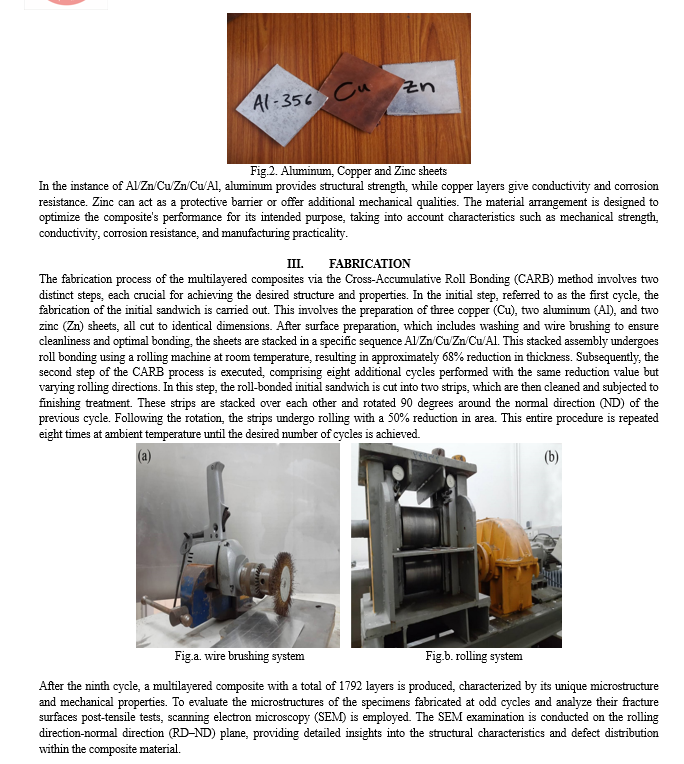

Additionally, phase analysis is performed using X-ray diffraction (XRD) techniques with the assistance of X'pert high-score software. The XRD tests are conducted within the 2-theta diffraction range of 30–90°, utilizing a precise step size of 0.03° and a step time of 3 seconds. These analyses contribute to a comprehensive understanding of the composition, crystalline structure, and phase distribution within the multilayered composites, facilitating further optimization of their properties for various applications.
IV. DLC COATING
In the pursuit of provide corrosion protection for multilayered materials, the application of a coating becomes necessary. Among the several coating alternatives, Diamond-like Carbon (DLC) stands out for its adaptability and efficacy in reducing corrosion rates while imparting diamond-like characteristics to the substrate. Among the different deposition processes available for depositing DLC coatings, Plasma Ion Immersion Deposition (PIID) stands out as particularly promising. PIID has a higher deposition rate and is more cost-effective than alternatives such as Chemical Vapor Deposition (CVD). Notably, PIID is well-suited for the deposition of hard coatings on multilayered composites and can easily handle big and complex structures. The PIID process begins with a thorough washing of the components in an alcohol solution to remove any surface contamination.
The cleaned components are then placed in a vacuum chamber that is kept under low pressure. Argon (Ar) gas is supplied into the chamber to aid in the creation of discharge plasmas. Applying a negative pulsed voltage, generally at 4KV with a pulse width of 20 µs and frequency of 1000 Hz, creates discharge plasma within the chamber. Argon (Ar) is then used for ion sputter cleaning, which is an important step in ensuring that the DLC coating adheres properly to the substrate. This sputter cleaning procedure normally takes 20 to 30 minutes and efficiently prepares the surface for DLC deposition. The deposition procedure entails injecting acetylene (C2H2) into the vacuum chamber, resulting in the formation of an amorphous carbon layer on the multilayered composite.
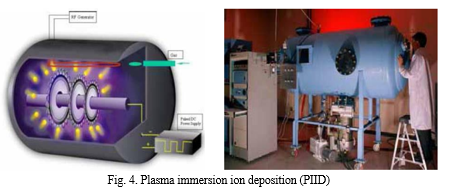
The DLC coating created by the PIID process has an amorphous structure with exceptional hardness and chemical inertness. Furthermore, the coating has hydrophobic capabilities, with water contact angles of up to 140° and negligible friction.
Following the application of the coating, the material's microstructure is thoroughly studied using scanning electron microscopy (SEM), which allows for extensive observation and analysis. Furthermore, the corrosion behavior of the deposited composite is carefully examined to ensure that the DLC coating is effective in improving corrosion resistance and increasing the lifespan of multilayered materials. Multilayered composites can benefit from strong and lasting DLC coatings by strategically applying the PIID process, protecting them from corrosion-induced deterioration and assuring long-term operational integrity in a variety of industrial situations.
V. CORROSION TEST
The corrosion characteristics of diamond-like carbon (DLC) coated multilayered composites; corrosion polarization tests were conducted in a 3.5 wt% NaCl aqueous solution at room temperature. Prior to the polarization measurements, the specimens underwent a stabilization period of 40 minutes in the solution to establish the open circuit potential (OCP). The electrochemical setup employed for these experiments consisted of a Gill AC system, which facilitated precise control and data acquisition. In this setup, the prepared specimens served as the working electrode, with Ag/AgCl and Pt electrodes utilized as the reference and counter electrodes, respectively. The electrochemical tests were driven by potentiodynamic polarization curves, a technique commonly employed to evaluate the corrosion resistance of materials. During the experiments, polarization was initiated at a rate of 0.166 mV s^-1, starting from -0.25 V (OC) SCE and progressing through the entire scan range. A carbon electrode was employed as the auxiliary electrode to support the electrochemical reactions occurring at the working electrode. The reference electrode, a saturated calomel electrode (SCE), provided a stable reference potential for accurate measurement. Notably, the standardized exposure area for all specimens was maintained at 1 cm² throughout the experimentation process.
The corrosion potential (Ecorr) of the specimens was determined as the point at which the anodic and cathodic branches of the Tafel curves intersected, providing valuable insights into the material's inherent corrosion resistance. Overall, these meticulously designed corrosion polarization tests enabled a comprehensive evaluation of the corrosion behavior of DLC-coated multilayered composites, shedding light on their suitability for various industrial applications.
VI. RESULT
A. Microstructure Analysis
The processing of multilayered composites through odd cycles of Cross-accumulative roll bonding (CARB) induces significant changes in constituent layers. As the number of CARB cycles increases, there is a noticeable decrease in layer thickness alongside an increase in their number, leading to a transition from smooth to wavy layers due to increased strain. Plastic instabilities and irregularities become evident from the third cycle onwards, manifesting as phenomena like necking, shear bands, and fractures, particularly in copper layers. Copper layers exhibit early necking due to their higher strain hardening exponent, followed by the formation of shear bands at intermediate cycles. These shear bands, characterized by limited areas highly strained at an angle of approximately 35 degrees with respect to the rolling direction, result from non-uniform strain distribution during rolling. With continued cycling and strain accumulation, the number of shear bands increases, leading to copper layer attenuation and eventual fracture. X-ray diffraction (XRD) analysis reveals characteristic peaks of copper, zinc, and aluminum, indicating the absence of chemical reactions among layers due to room temperature CARB processing. The crystalline size of the copper matrix decreases significantly with increasing CARB cycles, from about 255 nm at one cycle to 50 nm at nine cycles, indicating successful creation of ultrafine grains. The stacking fault energies of aluminum, zinc, and copper differ, influencing the mechanisms of grain refinement within the layers. Recrystallization dominates in copper and zinc layers with medium to low stacking fault energies, while grain subdivision prevails in aluminum layers with higher stacking fault energy. This results in varying grain sizes among constituents, with aluminum layers exhibiting larger grain sizes compared to copper and zinc layers.
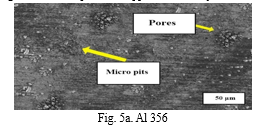
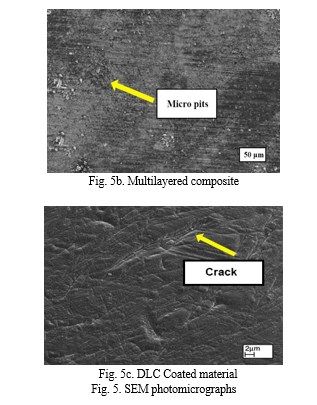
Furthermore, microstructural analysis through scanning electron microscopy (SEM) reveals the roughness of coatings in the tens of nanometers range, characterized by a generally smooth surface morphology with evenly dispersed carbon clusters. The presence of ferric chloride in the process aids in microscopic evaluations, showcasing good adhesion between the surface and diamond-like carbon coatings. Utilization of the plasma ion immersion technique enhances adhesion to materials, contributing to the integrity of the multilayered composite structures.
B. Corrosion Behaviour
The potentiodynamic polarization curves depicted in Fig. 6 illustrate the corrosion behavior of both raw sheets and composite samples processed at various Cross-accumulative roll bonding (CARB) cycles in a 3.5% sodium chloride solution.
Notably, corrosion tests were conducted on the rolling direction-transverse direction (RD-TD plane) of the samples, enabling the extraction of corrosion parameters such as corrosion potential and current density. Copper exhibits a more positive corrosion potential and lower corrosion rate compared to aluminum and zinc, as evidenced by Fig. 6a. With increasing applied strain, observed in Fig. 6b, the corrosion potential becomes more negative from the first to the ninth cycle, indicative of decreased corrosion resistance.
Macroscopic examination of the surface morphology, as illustrated in Fig. 6b, reveals significant changes in constituent layers with increasing CARB cycles. Initially, aluminum is predominantly present on the surface of the composite produced after the first cycle, gradually replaced by layers of zinc and aluminum in subsequent cycles. Consequently, aluminum and zinc layers adjacent to copper contribute to the formation of galvanic cells, diminishing the corrosion resistance of the samples. The presence of aluminum and zinc near the surface leads to an increase in corrosion current density with higher CARB cycles, indicating a decrease in corrosion resistance.
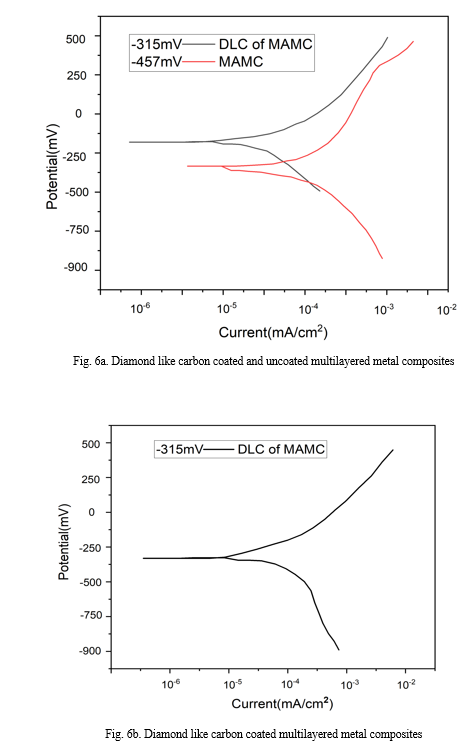
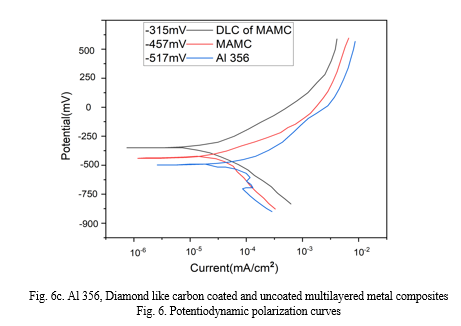
Furthermore, the DLC-coated multilayered composite undergoes corrosion testing in a 3.3% Sodium Chloride (NaCl) solution under various conditions. Polarization curves for both uncoated and DLC-coated samples demonstrate the remarkable corrosion resistance of DLC-coated materials.
An observed trend suggests that as deposition time increases, the corrosion resistance of the DLC film also increases, underscoring the effectiveness of DLC coatings in enhancing the corrosion resistance of multilayered composites. These findings emphasize the importance of surface coatings, such as diamond-like carbon (DLC), in mitigating corrosion and improving the overall durability of multilayered composite materials.
Conclusion
The investigation into the microstructure and corrosion behavior of diamond-like carbon (DLC) coated multilayered composites yields valuable insights into their performance and potential applications. Through techniques such as potentiodynamic polarization curves and microscopy analysis, key findings have been evaluated. Firstly, the microstructure analysis reveals changes in the microstructure of the multilayered composites as the number of CARB cycles increases. SEM analysis shows the development of plastic instabilities, shear bands, and fractures in copper layers, indicating plastic deformation and strain accumulation. XRD analysis confirms a reduction in copper matrix crystallite size and variations in grain size among constituent layers due to the CARB process. Moreover, SEM observations reveal the morphology of DLC coatings and their good adhesion to the substrate. Corrosion tests conducted in a 3.5% sodium chloride solution demonstrate a decrease in corrosion resistance with increasing CARB cycles. The emergence of aluminum and zinc layers on the surface leads to the formation of galvanic cells, contributing to decreased corrosion resistance. Corrosion potential becomes more negative with higher CARB cycles, indicating reduced corrosion resistance. However, DLC-coated samples exhibit significantly enhanced corrosion resistance compared to uncoated samples. The corrosion current density decreases with increasing deposition time of the DLC coating, highlighting the effectiveness of DLC coatings in mitigating corrosion. Finally, the DLC-coated multilayered composites have promising corrosion-resistant properties, making them viable candidates for applications in environments prone to corrosion. Further research could focus on optimizing DLC coating parameters to maximize corrosion protection and exploring additional characterization techniques to gain a comprehensive understanding of the microstructural changes and corrosion mechanisms in these composite materials.
References
[1] N. Kalantarrashidi, M. Alizadeh, Structure, wear and corrosion characterizations of Al/20wt% Zn multilayered composites fabricated by cross-accumulative roll bonding, J. Manuf. Process. 56 (2020) 1050–1058. [2] M.M. Mahdavian, L. Ghalandari, M. Reihanian, Accumulative roll bonding of multilayered Cu/Zn/Al: an evaluation of microstructure and mechanical properties, Mater. Sci. Eng. A 579 (2013) 99–107. [3] H.T. Gao, X.H. Liu, J.L. Qi, Z.R. Ai, L.Z. Liu, Microstructure and mechanical properties of Cu/Al/Cu clad strip processed by the powder-in-tube method, J. Mater. Process. Technol. 251 (2018) 1–11. [4] L. Wang, L.Q. Du, C. Li, X.H. Cui, X. Zhao, H.L. Yu, enhanced mechanical properties of lamellar Cu/Al composites processed via high-temperature accumulative roll bonding, Trans. Nonferrous Met. Soc. China 29 (2019) 1621–1630. [5] D.C. Tsai, Y.L. Huang, S.R. Lin, D.R. Jung, F.S. Shieu, Effect of nitrogen flow ratios on the microstructure and properties of (TiVCr) N coatings by reactive magnetic sputtering, Nucl. Instrum. Methods Phys. Res. Sect. B Beam Interact. Mater. At. 269 (2011) 685–691. [6] C.R. Lin, W.H. Liao, D.H. Wei, C.K. Chang, W.C. Fang, C.L. Chen, C.L. Dong, J.L. Chen, J.H. Guo, Improvement on the synthesis technique of ultra nanocrystalline diamond films by using microwave plasma jet chemical vapor deposition, J. Cryst. Growth 326 (2011) 212–217. [7] M. Mokhles, M. Hosseini, S.M. Zebarjad, H. Danesh-Manesh, Structure and mechanical properties of Ni/Ti multilayered composites produced by accumulative roll-bonding process, J. Compos. Mater. 54 (2020) 1–8. [8] H. Jafarian, S.M. Anijdan, A. Eivani, N. Park, A comprehensive study of microstructure development and its corresponding tensile properties in nano/ultrafine-grained metastable austenitic steel during accumulative roll bonding (ARB), Mater. Sci. Eng. A 703 (2017) 196–204. [9] A. Eivani, A.K. Taheri, A new method for producing bimetallic rods, Mater. Lett. 61 (2007) 4110–4113. [10] H. Jafarian, M. Mahdavian, S. Shams, A. Eivani, Microstructure analysis and observation of peculiar mechanical properties of Al/Cu/Zn/Ni multi-layered composite produced by Accumulative-Roll-Bonding (ARB), Mater. Sci. Eng. A (2020) 140556. [10] MOUSAVI S E, SONBOLI A, NAGHSHEHKESH N, MERATIAN M, SALEHI A, SANAYEI M. Different behavior of alpha and beta phases in a low stacking fault energy copper alloy under severe plastic deformation [J]. Materials Science and Engineering A, 2020, 788: 139550. [11] MOUSAVI S E, NAGHSHEKESH N, AHMADI F, SADEGHI B, CAVALIERE P. Effect of lead on the crack propagation and the mechanical properties of Brass processed by ECAP at different temperatures [J]. Materials Science and Engineering A, 2018, 728: 231?238. [12] MOUSSA M E, WALY M A, AMIN M. Effect of high intensity ultrasonic treatment on microstructural modification and hardness of a nickel?aluminum bronze alloy [J]. Journal of Alloys and Compounds, 2018, 741: 804?813. [13] MOUSAVI S E, MERATIAN M, REZAEIAN A. Investigation of mechanical properties and fracture surfaces of dual-phase 60--40 brass alloy processed by warm equal-channel angular pressing [J]. Journal of Materials Science, 2017, 52: 8041?8051. [14] LV Y, WANG L, HAN Y, XU X, LU W. Investigation of microstructure and mechanical properties of hot worked NiAl bronze alloy with different deformation degree [J]. Materials Science and Engineering A, 2015, 643: 17?24. [15] XU X, WANG H, LV Y, LU W, SUN G. Investigation on deformation behavior of nickel aluminum bronze by neutron diffraction and transmission electron microscopy [J]. Metallurgical and Materials Transactions A: Physical Metallurgy and Materials Science, 2016, 47: 2081?2092.
Copyright
Copyright © 2024 Stanley Ebenezer Nitla , Naresh Meka, Samuel Dinakaran Bandi, Tharun Bommidi, Amarnadh K. This is an open access article distributed under the Creative Commons Attribution License, which permits unrestricted use, distribution, and reproduction in any medium, provided the original work is properly cited.

Download Paper
Paper Id : IJRASET62015
Publish Date : 2024-05-12
ISSN : 2321-9653
Publisher Name : IJRASET
DOI Link : Click Here
 Submit Paper Online
Submit Paper Online

